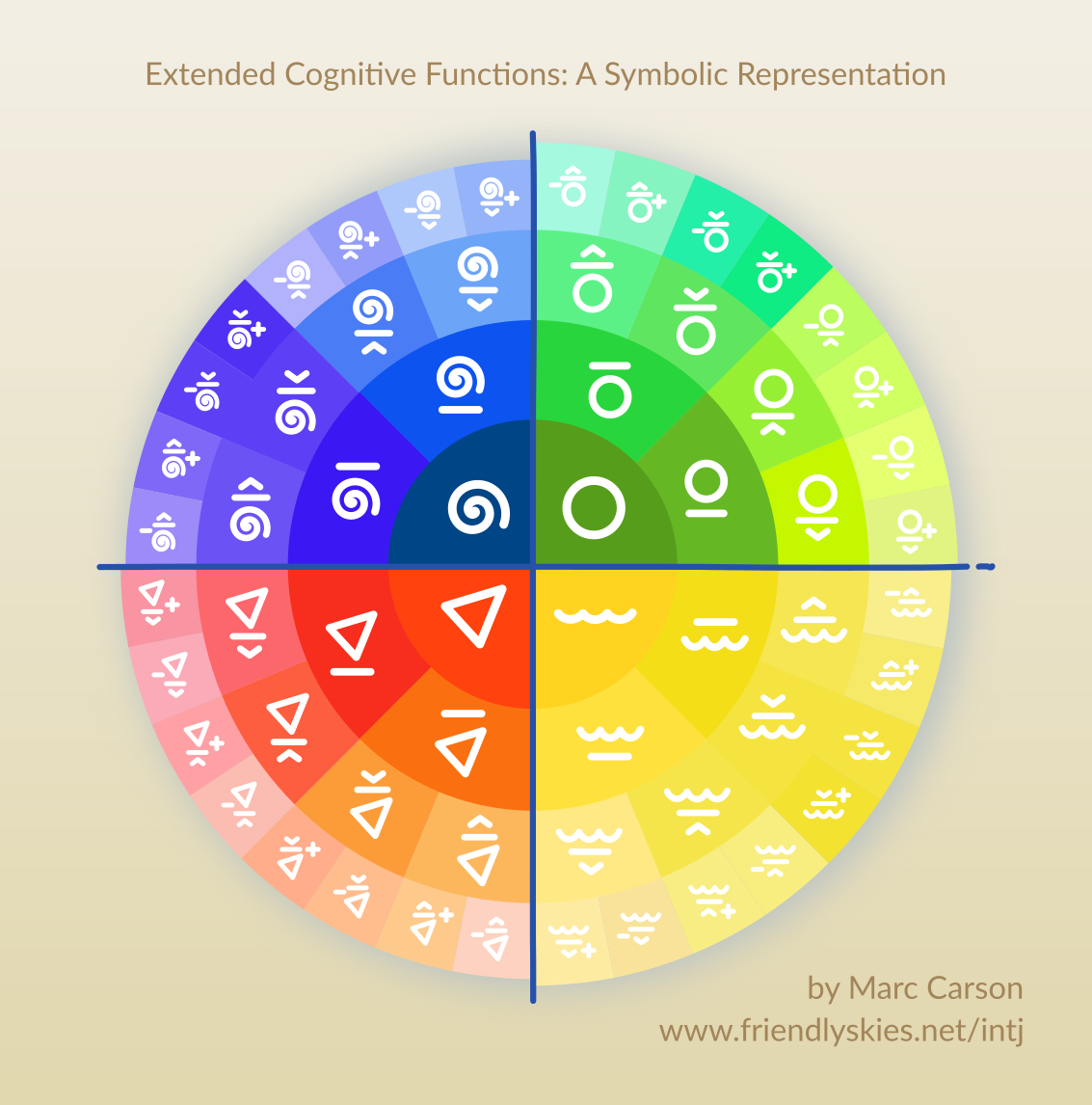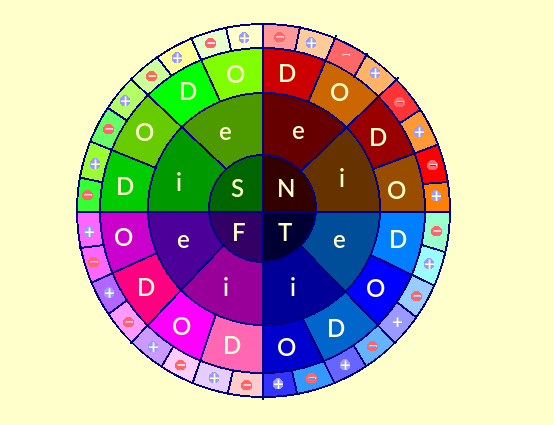Cognitive Function Extensions: D,O, Plus, Minus. Take 1.
Wednesday July 21, 2021
Here are some new cognitive function extensions I’ve been working on. The latest version is also symbolic:

This model helps to catalog the cognitive functionality that anyone can access. It’s not really about what “type” you are, though it can help you transition from standard personality type to knowing yourself even better.
The four symbols are:
- Spiral: Intuition
- Circle: Sensation
- Waves: Feeling
- Triangle: Thinking
The underline represents introversion, while the overline represents extroversion.
The carat symbol indicates whether information is being directed / organized / created (upward arrow) or observed / taken in (downward arrow).
The plus and minus indicate more about the nature of the use of the function (more below).
Here’s the older version of the graphic, with the letters, for ease of reference:

In terms of presentation this is really rough so far, but that’s mostly because it’s a fairly detailed model and it’s still first steps here.
New Suffixes
There are two new letter suffixes:
D: Directive use of the function (upward carat or arrow). Involves directing, cueing, or otherwise emphasizing changes that are to be executed.
O: Observant use of the function (downward carat or arrow). Involves observing, noting, or otherwise emphasizing things that are observed/sensed/perceived.
In this model, “Judging” functions T and F can be used for perception, and “Perceiving” functions N and S can be used in judgment (directive) tasks. I feel this more accurately describes the use of these functions in normal conversation.
There are also two other suffixes, the plus and minus:
+: Positive or constructive use of the function. Emphasizes things you should do or will do for positive effect, or that are happening / will happen / have happened for positive effect.
-: Negative, critical, or destructive use of the function. Emphasizes things that should not be done, or will not be done, or that are happening / will happen / have happened for negative effect.
Question Symbols
Since questions come up a lot in speech and thought, I’ve designated ‘x’ as a question mark substitute (borrowed from Gregg Shorthand). The x is written in lowercase unless it is denoted as subscript, in that case it would be capitalized. Here are question-type-specific notations:
- Questions as to the name or label of something/someone: xa
- Questions as to how a thing is, or why it is: xh
- Questions as to the properties of a thing (size, weight, color…or meaning, if coupled with N functions): xp
- Questions as to where a thing is: xr
- Questions as to when a thing happened/happens: xn
Where is my car? SeO+xr
Why did your friend come so late? TeO-xh
What is the meaning of this black feather on my pillow? SeO-xh
What is the meaning of life? NiO+xp
What could life possibly mean? NeO+xp
I went by mom’s house today and found this old cassette recorder. I think it will fit our plans perfectly. Do you like it? SiO+ —> SeO+ —> NiO+ —> FiO+xh
There is a lot of room for argument as to which functions are used here. I think of this as more of a Lego-like language, or a language for inspiring more questions about people, instead of a precise replication language. So you could even simply say that the example here concerns an issue of NiD+xp, or what we ought to do to achieve a future outcome. But it would be even better to actually ask the subject about that—to what degree does that conclusion seem true to the subject?
I’d rather use the terms to ask questions or stimulate thinking, than to delineate sides in an argument. Each viewpoint may have its own unique leverage. Hold your models lightly…
For Best Use
- Think about some sentences or types of statements that a friend or coworker says a lot. How do those statements show a functional position? Are they Directive, or Observant? More plus, or more minus? Which function and attitude (E or I) do they seem to indicate? What might this say about their preferred way of looking at life, or making decisions?
- Write in your journal and review what you’ve written. What functional positions are reflected?
- Which functional positions seem interesting to you?
- Which functional positions seem to irritate you, if any? Which do you struggle with at work, or in relationships?
Below I’ve written up the entire group, providing examples where possible:
- Ne: (Extroverted Intuition)
- Directive D+/-
- + Get everybody to contribute their ideas. No idea should be considered unworthy or dumb!
- - Don't do it the old-fashioned way unless you want old-fashioned results.
- Observant O+/-
- + Air traffic can be compared to fish swimming in a river.
- - You're stuck on all these old ideas. Let some creativity in!
- Ni: (Introverted Intuition)
- D+/-
- + Buy this stock today and you'll likely triple your money by this time next year.
- - CONCEPT (Contingency) Don't rent an apartment within earshot of that railroad track or you'll hear trains all night.
- O+/-
- + CONCEPT / Future: In the future people will live more like animals, but in a good way.
- - METAPHOR / Now: The person running the hot dog stand is a real snake.
- Se: (Extroverted Sensation)
- D+/-
- + Jump up and down a few times, it'll get you warmed up.
- + To be an impressive person in this group I ought to wear a really new set of clothing.
- - You'll be misunderstood if you frown like that while dancing to happy music.
- - Don't speak so quietly. People will never notice you.
- O+/-
- + The loud music makes me feel alive.
- + This food is fresh.
- - This cassette player is old.
- - That person is getting all the attention by laughing loudly; everyone is looking at them.
- Si: (Introverted Sensation)
- Directive D+/-
- + Emphasize our traditions in your talk to the new employees.
- - Don't ignore my important dates and family traditions or we can't be together.
- - Don't put those two foods together, that's disgusting. PB&J has no "A" for apples.
- Observant O+/-
- + We used to sit under this tree and eat those yummy pastries together, remember?
- - That's not how things are done around here. We have been in the business for years, so don't argue until you know the ropes.
- Te: (Extroverted Thinking)
- Directive D+/-
- + Count your calories and you'll lose weight. Measurement yields control.
- + I should start that project today so I have enough time to finish it by the end of the month.
- - Nobody does things that way anymore. It's totally dumb.
- - Stop completing your work so late.
- Observant O+/-
- + Using the new system, our profits went up by 20% and we did 30% less work!
- - You made us late again. How is it this hard to get to work a few minutes early?
- Ti: (Introverted Thinking)
- Directive D+/-
- + When you get to Level 2 of the game, go into the first door on the right and push on the right side of the bookcase.
- - Stop telling that person you disagree with them, if you want them to like working with you.
- Observant O+/-
- + If you take two away from a group of three, you get one.
- - It seems like a dumb idea to walk on the oncoming-traffic side of the road if you don't want to get hit by that oncoming car.
- Fe: (Extroverted Thinking)
- Directive D+/-
- + Always thank the person who introduced you before your speech.
- - Ditch that loser and move on with your life.
- Observant O+/-
- + Everyone on the team is united under the noble principles of our cause.
- - That person has horrible breath and wears tacky clothing.
- Fi: (Introverted Thinking)
- Directive D+/-
- + You should talk to people and get to know them better, even if you know they could hurt you.
- - Don't accept public praise and rewards that you privately know you don't deserve.
- Observant O+/-
- + I value relationships that are co-creative.
- - I don't like it when people make fun of others who are in vulnerable situations.
Note: This model does include plus and minus, which I think I’ve mentioned before are also used in at least one Socionics model, but the use there has varying characteristics and I am treating my pluses and minuses here as distinct. Kind of like the way the letters can mean different things depending on the model, even if the models use the same letters.
Filed in: Socionics /7/ | Ni /42/ | Fi /35/ | Te /36/ | Control /111/ | Publications /44/ | Ne /17/ | Thinking /70/ | Fe /20/ | Ti /30/ | Sensation /40/ | Therapeutic Practice /145/ | Feeling /64/ | Intuition /63/ | Si /19/ | Se /25/ | Productivity /120/
Recent Articles
Just Writing to Write, Just Expressing Because it's Life →
The NT Factor: How Harris and Walz's Personality Types Could Shape Their Presidential Bid and/or Presidency →
Predictive Contenders: Allan Lichtman (ENTP) and Cenk Uygur (INTJ) on US Presidential Election Predictions →
How to Organize & Structure a New Binder or Notebook (Fractal Method) →
Sharpening, Reading, Listening, Watching, Timing. →
Things I Made for You
Own your procrastination with Whole Productivity, a new system → Get my free INTJ COVID-19 Guide → Explore your gifts with my INTJ Workbook → Other Publications → ...and the fake word of the hour: "Atanerkber." Pretty sure it has to do with feats of daring.
